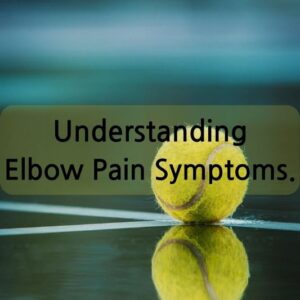Elbow pain can be debilitating, affecting one’s ability to perform daily tasks and engage in physical activities. Understanding the symptoms of elbow pain is crucial for proper diagnosis and effective treatment. In this article, we delve into the various causes, diagnosis methods, and treatment options for elbow pain symptoms.

What Causes Elbow Pain?
Elbow pain can stem from various underlying conditions, including:
- 1. Tennis Elbow (Lateral Epicondylitis)
- 2. Golfer’s Elbow (Medial Epicondylitis)
- 3. Arthritis
- 4. Bursitis
- 5. Fractures or Dislocations
- 6. Tendinitis
- 7. Cubital Tunnel Syndrome
- 8. Nerve Compression
Recognizing Symptoms
Identifying the symptoms associated with elbow pain is essential for early intervention and treatment. Common symptoms include:
- 1. Pain and Tenderness
- 2. Swelling and Inflammation
- 3. Limited Range of Motion
- 4. Numbness or Tingling Sensation
- 5. Weakness in the Arm
- 6. Difficulty Gripping Objects
- 7. Stiffness in the Elbow Joint
Diagnosis Methods
Diagnosing the underlying cause of elbow pain requires a comprehensive evaluation by a healthcare professional. Diagnostic methods may include:
- 1. Physical Examination
- 2. Medical History Review
- 3. X-rays
- 4. MRI or CT Scans
- 5. Electromyography (EMG)
- 6. Ultrasound Imaging
Treatment Options
Treatment for elbow pain symptoms varies depending on the underlying cause and severity of the condition. Common treatment options include:
- 1. Rest and Activity Modification
- 2. Ice and Heat Therapy
- 3. Pain Medications
- 4. Physical Therapy
- 5. Steroid Injections
- 6. Occupational Therapy
- 7. Splinting or Bracing
- 8. Surgery (in severe cases)
Preventive Measures
Preventing elbow pain involves adopting healthy habits and practices, including: 1. Proper Technique in Sports and Physical Activities 2. Regular Stretching and Strengthening Exercises 3. Using Protective Gear and Equipment 4. Taking Breaks During Repetitive Tasks 5. Maintaining Good Posture
Conclusion
Elbow pain symptoms can significantly impact daily life and functionality. By recognizing the signs, seeking timely medical evaluation, and adopting preventive measures, individuals can effectively manage and alleviate elbow pain.
FAQs (Frequently Asked Questions)
1. Can elbow pain be a sign of a more serious condition?
Elbow pain can indicate various underlying conditions, some of which may require medical intervention. It’s essential to consult a healthcare professional for proper diagnosis and treatment.
2. How long does it take for elbow pain to heal?
The healing time for elbow pain depends on the underlying cause, severity of the injury, and individual factors. Following the recommended treatment plan and rehabilitation exercises can expedite the healing process.
3. Is surgery always necessary for treating elbow pain?
Surgery is not always necessary for treating elbow pain. Conservative treatments such as rest, physical therapy, and medication may suffice for many individuals. However, in severe cases or when conservative measures fail, surgery may be recommended.
4. Can elbow pain be prevented?
Adopting proper techniques during physical activities, incorporating stretching exercises, using protective gear, and maintaining good posture can help prevent elbow pain and injuries.
5. When should I seek medical attention for elbow pain?
If elbow pain persists despite rest and home remedies, worsens with activity, or is accompanied by severe swelling, deformity, or inability to move the elbow, it’s crucial to seek prompt medical attention.
Find out more about elbow pain!
